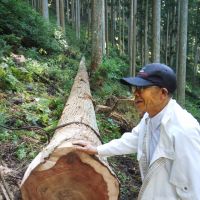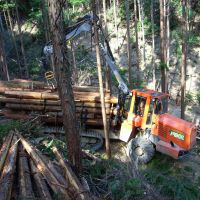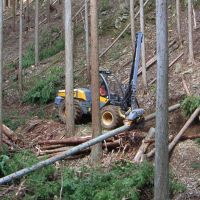Ialways found it hard to think of single-species conifer plantations as real forests, but over the 32 years I have lived in the Shinshu area of northern Nagano Prefecture, that feeling has become even stronger.
Here, the ubiquitous cover of sugi (Japanese cedar) and karamatsu (Japanese larch), usually untended for decades, is made up of trees growing so close together that they stop light reaching the ground. As a result, other plants die and steep slopes become prone to erosion for want of the roots of shrubs and grasses to absorb heavy rainfall.
In such tightly packed woodlands, the trees' light-starved lower branches also die off and, with only the treetops in the sun, trunk growth is minimal. In Japanese cedars, this often triggers the production of excessive amounts of pollen in what is no doubt an evolutionary attempt by ailing individuals to ensure the survival of the species. This, however, causes medical problems for people across huge areas of Japan who suffer from pollen allergies.
Recently, I had the chance to visit a magnificent forest of Japanese cedar and hinoki (Japanese cypress, Chamaecyparis obtusa) that has been nurtured by the Okahashi family for 17 generations on the steep slopes of Mount Yoshino in Nara Prefecture.
Mount Yoshino is most famous for its eponymous, natural hybrid cherry trees known as somei-yoshino (Yoshino cherry, Prunus × yedoensis), thousands of which grow up the side of the mountain for several hundred meters. Those on the lower slopes bloom first, then the blossoming gradually ascends and, as a result, the cherry-blossom season there can last up to a month.
In August this year, when a typhoon brought extremely heavy rains, there were massive landslides on mountain slopes in Nara Prefecture and on the Kii Peninsula of adjoining Mie Prefecture — especially those with plantations of conifers that have been neglected, clear-cut, or otherwise badly managed over the last three decades or so.
Not so the forest on Mount Yoshino that has been carefully nurtured and harvested by the Okahashi family for 300 years.
It was to this sylvan gem that I and four companions — my manager, Mrs. Morita, Mr. Matsuki, our chief forester at the Afan Woodland Trust in Kurohime, Nagano Prefecture, Mr. Ishii, our Trust manager and forester, and Prof. Takeuchi, who has recently retired from the forestry department at Kyoto University — were all taken by the outdoor writer and activist Reiko Amano to meet the Okahashi brothers.
There they do selective logging and do not strip the mountainsides bare. Consequently, though the very young trees are not much different to look at from those in the national forest plantations adjoining our woods in Kurohime, the overall difference in the woodlands is very marked indeed.
For example, cedar and cypress trees in a plantation that has been carefully tended and trimmed out for 70 years have an average diameter at chest height of around 39 cm, and their high-quality timber ensures they are easily marketable.
In the Yoshino forests, going through tall, straight stands of cedar and cypress of increasing ages we came to one where the trees are 250 years old and have an average diameter at chest height of more than a meter. These would be the kind of trees needed to rebuild Japanese temples. They are worth a lot of money.
Old-growth plantations of cedar or cypress are stately, and beautiful. Although there is no real biodiversity in the trees themselves, many bushes, flowers, ferns, mosses and other plants grow beneath them, attracting a lot of wildlife. We saw deer running up the slope as our 4WD Delica lurched up the narrow road, and when we stopped and the engine was turned off, birdsong filled the air. As well, the many streams we saw all ran crystal clear, even though there had been heavy rains the day before and during the night.
The Okahashi brother's firm, Seiko Forestry Company, is expert at building stable logging roads on steep mountain slopes. They use smaller trees that have been trimmed out to make lattices over which they spread rocks and earth to form the roadbeds. Many of those we drove on were white-knuckle rides — longer, higher and more scary than any fairground roller-coaster I've been on — yet they regularly take logging equipment and 2-ton trucks.
The banks of these roads grow green and pretty after a few years, and though they are steep they are good to walk on and would make fantastic hiking or mountain-bike trails when there is no timber extraction going on.
Also, and importantly, although regular Japanese logging roads are notoriously expensive to build, we saw a newly completed 3-km one on a serious gradient that had taken five men 18 months to complete — at a cost of only ¥6,000 per meter. The Okahashi brothers assured us that such roads needed little maintenance and would last for decades.
Bidding farewell to our Yoshino-forest hosts, we headed off to the small town of Hiyoshi, north of Kyoto, to visit Mr. Yuasa, chief of the Hiyoshi Forest Owners Co-operative. Mr. Yuasa is an enthusiastic, outspoken fellow whom I have met at several forestry events and who has twice visited our Trust woods — the last time this June, with his whole crew.
Earlier this year, a senior forestry union officer had confided to me that of the 700-odd forestry co-operatives in Japan, only 10 are really operating efficiently and most survive on government handpouts because they couldn't keep going by producing marketable timber.
The Hiyoshi co-operative is one of the 10 — being dynamic, efficient and productive. It has a membership of 1,000 forest owners who contract with them to assess, then selectively cut and market the trees. The co-operative also clears brush on members' land and improves or constructs logging roads.
The co-operative's office is run like a command center. The tasks, location and needs of each worker and machine are clearly marked on a multicolored work-flow chart on a wall, and at the end of each day the loggers, machine operators, office staff and managers all get together for a meeting that lasts about 20 minutes. That's how inclusive and efficient they are.
Most of the woods the co-operative manages start out as long-neglected single-species plantations of cedar, larch or cypress. Typically, most of the trees are spindly, and are not worth much except for pulp or to convert into wood pellets for biomass heaters. Even so, the co-operative's efforts are so productive, and its dealings are so transparent, that all owners make some money. In time, too, their remaining trees will grown larger and become more valuable.
The woods under the co-operative's management also become easy to access and, with light reaching the ground, they are green and pleasant places in which flowers bloom and where mushrooms and mountain vegetables can be grown and/or harvested.
The co-operative uses a Sampo Rosenlew harvester from Finland, which has four huge tires that allow it to go almost anywhere and do far less damage to the forest floor than any tracked vehicle. The machine has a telescopic arm that can reach out and grab a tree, cut it and hold it lengthwise as the machine's blades strip the branches and cut the trunk into required lengths before stacking them ready for another vehicle called a forwarder to pick up.
The forwarder, made in Japan by IHI Kenki Co. Ltd., was another impressive bit of kit, with its huge front wheels, a pair of heavy-duty rubber tracks at the back and a crane operated by the driver from the safety of its cabin. With a heavy load of logs, this forwarder can turn steep corners on narrow roads far more safely than any truck.
Then, when the harvester and forwarder have left and timber extraction is finished, the forest floor is cleaned up and not left in a mess, and streams are cleared of woody debris than could pile up as dams and cause flash floods. All in all, this was easily the most efficient mechanized forestry I have ever witnessed in Japan — and a lot better than much of what I've seen in Canada or other parts of the world.
The co-operative's workers are mostly young and come from all over the country and all walks of life. They are keen and clearly proud of what they do. I take my helmet off to them — and wish there were many more like them helping to salvage Japan's untold thousands of woefully neglected and unproductive woodlands.





